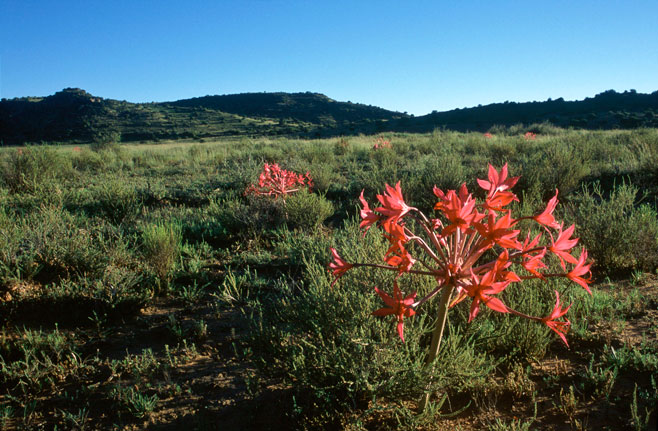Brunsvigia radulosa
(Candelabra flower)
Kandelaarblom, Misryblom [Afrikaans]; lematla [South Sotho]; lilula
[Swazi]
Life
> eukaryotes >
Archaeoplastida >
Chloroplastida
>
Charophyta > Streptophytina > Plantae (land plants)
> Tracheophyta (vascular plants) > Euphyllophyta > Lignophyta (woody plants)
> Spermatophyta (seed plants) > Angiospermae (flowering
plants)
> Monocotyledons > Order:
Asparagales
> Family: Amaryllidaceae > Genus:
Brunsvigia
 |
|
Brunsvigia radulosa. North of Colesberg,
Great Karoo, South Africa. [photo
Colin Paterson-Jones ©] |
See
KwaZulu-Natal Wildflowers by Elsa Pooley p. 348
See
Transvaal Lowveld and escarpment wild flowers by Jo Onderstall p. 54
Ecological interactions
Pollinators
Ward and Johnson (2005) found that
Brunsvigia radulosa was self-incompatible and adapted for
pollination mainly by the long-proboscid fly Philoliche
aethiopica (Tabanidae).
In areas where the fly is locally extinct (probably the result of
habitat fragmentation), carpenter bees (Xylocopa) appear to
act as substitute pollinators. However, they are less effective than
the fly and this appears to have resulted in lower seed production
in small populations of Brunsvigia radulosa.
Publications
- Ward, M., Johnson, S.D. 2005 (published online 2004). Pollen
limitation and demographic structure in small fragmented
populations of Brunsvigia radulosa (Amaryllidaceae).
Oikos 108(2): 253-262. DOI: 10.1111/j.0030-1299.2005.13468.x
|
